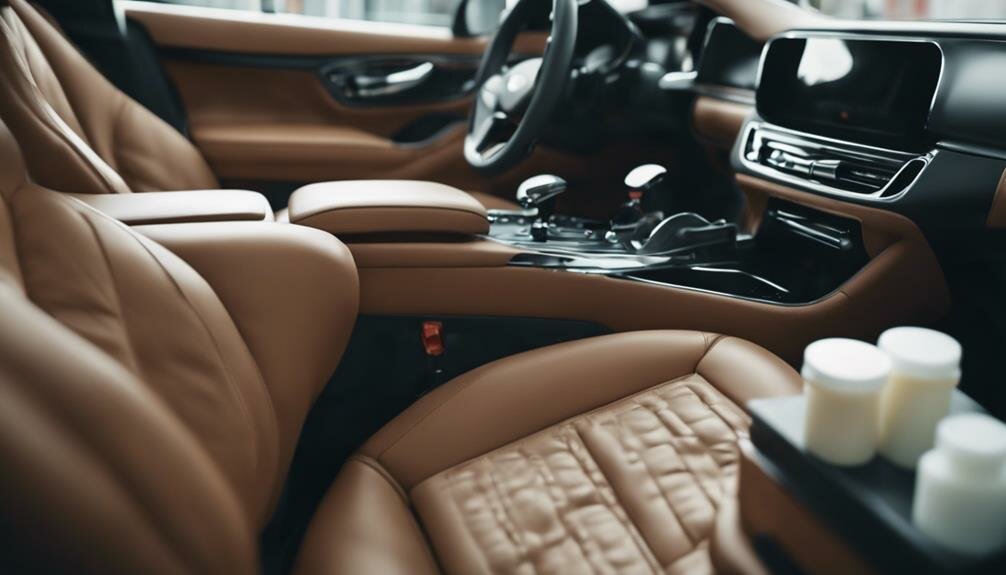To protect your car's leather seats, follow these steps:
- Regular Cleaning Routine:
- Dust and vacuum with a soft brush attachment, ensuring thorough cleaning.
- Using the Right Products:
- Choose microfiber cloths, soft-bristle brushes, and trusted leather cleaners like Lexol or Meguiar's.
- Conditioning the Leather:
- Clean before conditioning, apply in circular motions, let it absorb for 15 minutes, and buff. Do this every 3-6 months.
- Protecting Against Sun Damage:
- Use window shades, consider tinting, and employ full or partial car covers.
- Immediate Spill Management:
- Blot spills quickly, clean non-water spills with a mild cleaner, and dry thoroughly.
Embrace these tips for lasting leather seats.
Regular Cleaning Routine

A consistent cleaning routine keeps your car's leather seats looking pristine and extends their lifespan. To start, you'll want to focus on vacuuming seats regularly. This simple step removes dust and small debris that can cause wear and tear on the leather surface. Make sure to use the appropriate attachments, like a soft brush, to avoid scratching the material.
Steps for Dust Removal and Vacuuming
- Initial Dust Removal: Use a soft microfiber cloth to gently wipe down the seats. This helps in removing surface dust and prevents it from being ground into the leather when you vacuum.
- Vacuuming Seats: Attach a soft brush to your vacuum cleaner. Carefully run it over the entire seat, paying special attention to crevices and seams where dirt tends to accumulate.
- Inspect and Repeat: After vacuuming, inspect the seats for any remaining dust or debris. If needed, repeat the process to make sure thorough cleaning.
Maintaining this routine helps keep your leather seats free from dust and dirt, which can degrade the material over time. Regular attention to these small details can make a big difference in preserving the quality and appearance of your car's leather seats.
Using the Right Products
Using the Right Products
Selecting the appropriate products is essential for maintaining your car's leather seats and ensuring their longevity. It's important to choose both cleaning tools and product brands wisely to avoid damage and keep the leather looking its best.
Cleaning Tools
- Microfiber Cloths: These are perfect for wiping down leather seats without causing scratches.
- Soft-Bristle Brushes: Use these for cleaning dirt and grime from seams and crevices.
- Vacuum with Brush Attachment: Before applying any product, vacuum the seats to remove loose dirt.
Product Brands
- Leather Cleaners: Brands like Lexol, Chemical Guys, and Meguiar's offer specialized leather cleaners. These products are formulated to clean without stripping the leather's natural oils.
- pH-Balanced Solutions: Look for pH-balanced cleaners that won't damage the leather. Avoid household cleaners or detergents as they can be too harsh.
- Leather Wipes: For quick touch-ups, leather wipes from brands like Armor All can be very convenient. They clean effectively while being gentle on the leather.
Conditioning the Leather

Conditioning the leather helps maintain its softness and prevent cracking over time. Regular conditioning is crucial to keep your car's seats looking new. Start by choosing a high-quality leather conditioner designed specifically for automotive leather. Make sure the product is free of harsh chemicals that could damage the leather.
Steps to Condition Leather Seats
- Clean the Seats: Before applying the leather conditioner, make sure the seats are clean. Use a gentle leather cleaner and a soft cloth to remove any dirt and grime.
- Apply the Conditioner: Pour a small amount of leather conditioner onto a soft cloth. Gently rub the conditioner into the leather using circular motions, ensuring even coverage.
- Let It Absorb: Allow the conditioner to soak into the leather for at least 15 minutes. This helps the leather absorb the moisture it needs to remain supple.
- Buff the Seats: After the conditioner has been absorbed, use a clean, dry cloth to buff the seats. This will remove any excess product and leave the leather with a smooth finish.
Application Frequency
Condition your car's leather seats every three to six months. This frequency guarantees that the leather remains hydrated and prevents it from drying out and cracking. Regular conditioning will extend the life of your car's leather seats, keeping them in top condition.
Protecting Against Sun Damage
Protecting Against Sun Damage
To protect your car's leather seats from sun damage, start by using a sunshade whenever the vehicle is parked. Sunshades help block harmful UV rays, which can cause the leather to fade and crack over time. Place the sunshade on the windshield and rear window to guarantee thorough protection.
Use Window Shades
- Install Window Shades: These can be particularly useful for side windows. They reduce the amount of direct sunlight entering the car, keeping the interior cooler and safeguarding the leather from UV exposure.
- Tinted Windows: Consider getting your car windows tinted. Window tinting can block a significant amount of harmful UV rays, offering added safeguarding for your leather seats.
Employ Car Covers
- Full Car Covers: When parking your car for extended periods, use a full car cover. This provides complete safeguarding from the sun, along with other environmental factors like dust and bird droppings.
- Partial Car Covers: If a full cover is too cumbersome, consider a partial car cover that focuses on protecting the interior. These are easier to manage and still offer substantial safeguarding.
Regularly using these methods will extend the lifespan of your car's leather seats, keeping them in good condition for years.
Immediate Spill Management

Immediate Spill Management
When a spill happens on your car's leather seats, acting promptly is crucial to prevent any long-term damage. A quick response is critical because leather is porous and can absorb liquids quickly, leading to stains and deterioration. Here's how you can manage spills effectively:
Steps to Follow
- Blot the Spill: Use a clean, dry cloth to blot the spill. Avoid rubbing, as this can spread the liquid and push it deeper into the leather. The blotting technique helps to absorb as much liquid as possible without damaging the material.
- Use a Mild Cleaner: If the spill is something other than water, like juice or coffee, follow up with a mild leather cleaner. Apply it to a cloth first, then gently dab the affected area.
- Dry the Area: After cleaning, make sure the spot is dry. Use another dry cloth to blot any remaining moisture. Leaving leather wet can lead to mold or mildew.
Preventive Tips
- Keep Cleaning Supplies Handy: Always have a cleaning kit in your car. Fast access to the right tools can make a quick response much easier.
- Regular Conditioning: Condition your leather seats regularly. This can help them repel liquids better and make cleaning up spills simpler.





